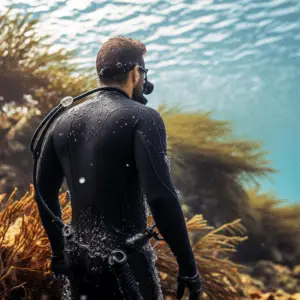Everyone knows what a wetsuit is or at least what it’s supposed to look like. Maybe if you are even more knowledgeable, you will even know how much a wetsuit costs.
Wetsuits are full-body neoprene suits that insulate swimmers and divers as they dive deeper. Divers and swimmers are exposed to very low temperatures, which can cause hypothermia or delirium.
Many people know about wetsuits, but few know that they exist in different thicknesses at different temperatures. Here are the optimal thicknesses for each temperature.
7mm- 5 degrees

7mm wetsuits are the thickest and best for really cold water. This thickness is best for divers who want to dive in snow or rain. Since 7mm is thick enough to protect you from ice water, this wetsuit is also beneficial in colder weather. Many people worry that heavy wetsuits will impede flexibility and movement, but this is not true. Neoprene is flexible, so even thick pieces can move.
Wetsuits of this thickness are even perfect for when you plan on going on deep dives and falls under the recommended gear that you use when doing so, along with a scuba diving full face mask. This is because the water actually feels much colder the deeper down you go, so if you plan on going quite deep, you will want a protective layer.
6mm- 6 degrees
This wetsuit thickness is suitable for colder months but not for freezing water. In winter, between November and February, professional divers and swimmers adapt to 6mm wetsuits. Although these wetsuits are thicker, specific methods are taken to dry them faster. The worst thing is springing out of the water in winter and having to wait for a thick layer of wet material to dry, thus most wetsuit manufactures aim to prevent this.
5.5mm 9 degrees
Upgrade your normal wetsuit thickness to 5.5mm in winter and fall when the weather drops. This is great for when the water cools and even in summer for those who don’t like the cold. People who are less cold-sensitive like this thickness for winter since it feels less restrictive. Surfers prefer this thickness in the winter because it dries quickly and keeps them comfortable in and out of the pool.
5mm-11 degrees
Once winter water cools, this is the lightest suggested wetsuit. This is useful in the sea and on the beach in a cold breeze. Though this thickness is normally adequate to keep you warm in the winter, some advocate wearing an insulating underlayer because the water temperature might change as it becomes colder, making you quite cold the deeper you go.
4.5mm- 12 degrees
This thickness is perfect for the fall weather where temperatures really start to plummet and the air gets colder.At this time of year, it can start off warm and turn chilly as clouds obscure the sun. Again, many divers and surfers recommend wearing a layer of insulation under the wetsuit because the weather can change throughout the day and make the water warmer or colder.
4mm- 14.5
This thickness is worn year-round and provides somewhat more warmth than a 3mm wetsuit. When summer ends and evenings cool, many individuals wear this wetsuit. This thickness is well-insulated, but winter and autumn are too chilly for it. If you can’t afford a new wetsuit, an insulated undershirt might help you stay warm.
3mm- 16.5 degrees
Due to the fact that most watersports take place during the summer, the 3mm wetsuit is probably the wetsuit that you are most familiar with. This wetsuit is one of the most commonly used wetsuits all year round and is a go-to in the warmer months. This swimsuit is rather thin and so is perfect for the hottest months of the year, where the water is warm and the last thing that you want is to feel constrained by a thick material. People also use this wetsuit thickness as they go into fall, with the support of a couple of insulating layers underneath.
Which thickness is right for you?

The user picks their thickness. Everyone’s thickness is different, therefore there are various factors to consider. Because they are well-insulated, people with higher body fat may choose a thinner wetsuit. A person with a lower body fat percentage may need a larger swimsuit year-round to keep heat underwater. Swimming and diving are strenuous sports that can make you sweat, therefore many people prefer thinner wetsuits to minimize overheating.
